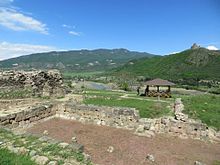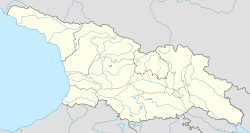Armazi
 The ruins of a six-column hall in the Armazi palace on Mount Bagineti (1st century BC). | |
| Location | Kartli, Georgia |
|---|---|
| Coordinates | 41°49′N 44°40′E / 41.817°N 44.667°E |
| Type | Settlement |
| Site notes | |
| Condition | In ruins |
Armazi (
Archaeology
Minor excavations on the territory of Armazi carried out in 1890 revealed the plinth of adobe town walls, with stone steps, and cleared the two-room structure, where fragments of a woman's torso of the 1st century AD were discovered. From 1943 to 1948 large-scale excavation was undertaken under
The three major cultural layers have been identified: the earliest dates back to the 4th-3rd century BC (Armazi I), the middle one is from the 3rd-1st century BC (Armazi II), and the relatively newer structure belongs to the 1st-6th century AD (Armazi III). Armazi I is constructed of massive stone blocks forming an impregnable base but were finished off by less durable mud brick. It also contains a great hall of six columns with a tiled roof. Armazi II is noted for a temple with an apse. Armazi III is the richest layer constructed of elegantly cut stone blocks, joined together with lime mortar and metal clamps. Among the surviving structures are the royal palace, several richly decorated tombs, a bathhouse and a small stone mausoleum.[1]
The area is now a state-protected field museum administered as a part of the National Archaeology Museum-Reserve of Greater Mtskheta.[2]
History

Archaeological evidences testify that the ancient Armazi was far more extensive than it is today. Armazi's strategic situation was dictated by its ready access to the
The name of the city and its dominant
Even after the rise of Mtskheta as a capital of Iberia, Armazi remained the holy city of Iberian
During this period, Armazi was governed by a hereditary
Armazi played a central role in ancient Georgian cultural life and in the evolution of local epigraphy in Georgia, prior to the invention of the
With the transfer of the Georgian capital to
The city of Armazi has never been revived since then, but a
See also
References
- ^ a b c Lang, David Marshall. "Armazi". Encyclopædia Iranica Online Edition. Accessed on September 13, 2007.
- ^ Georgian Museums: National Archaeology Museum-Reserve of Greater Mtskheta.[permanent dead link] Ministry of Culture, Monuments Protection and Sports of Georgia. Accessed on September 13, 2007.
- ISBN 0-521-33887-5.
- Lang, David Marshall. "Asparukh" Archived July 12, 2008, at the Wayback Machine. Encyclopædia IranicaOnline Edition. Accessed on September 13, 2007.
External links
- (in Georgian) Historical monuments of the Mtskheta District. The Mtskheta-Mtianeti Regional Administration.
- The Bilingual Inscription from Armazi (1st century AD) (Greek and Aramaic texts with German translation) The Armazi Project. Open Society – Georgia Foundation.
- Ruins on Mount Bagineti. Fund "Udabno".
- Mt. Bagineti (Archived 2009-10-25). Photos by Revaz Zhghenti.

